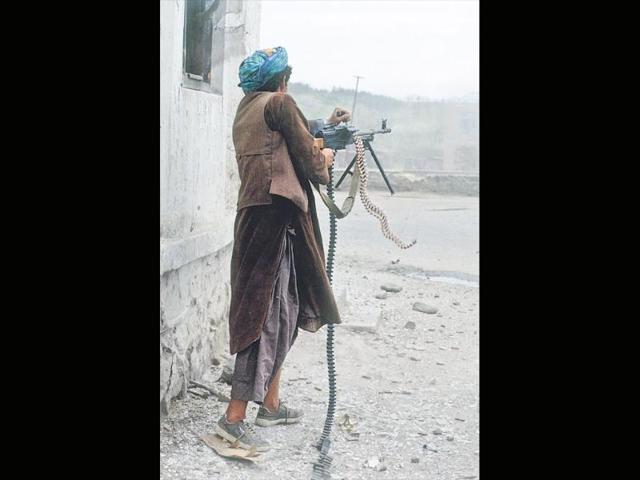A look into Robert Nickelsberg's record of Afghanistan and modern warfare
Robert Nickelsberg’s superb new collection of photographs of Afghanistan is an extraordinary record of modern warfare playing out in medieval conditions. Nic Dawes reviews Nickelsberg's Afghanistan: A Distant War.
Robert Nickelsberg arrived in Afghanistan in the spring of 1988 via Delhi, just as the defeated Soviet army was beginning its long retreat, broken by a decade-long battle with Mujahideen fighters backed by the United States, Pakistan, and Saudi Arabia.

It was, as we now know, the beginning of the end of the Cold War. The enormous resources, human and financial, poured into holding onto “the graveyard of empires” had helped fatally to weaken the Soviet system. It was also the moment at which the realignment of old forces into the tangled and contradictory coalitions that drive the defining conflicts of the 21st century began to take place.
Within a few years, heavy Pakistani backing would help build the Taliban into a force strong enough to take Kabul, and turn Afghanistan into an incubator of global jihad, which ultimately brought American and NATO troops to the country for their own long, draining, war.
Nickelsberg’s superb new collection of photographs, spanning this period, is published as the US and NATO move toward the planned cessation of combat operations by the end of this year.

An image of Soviet forces rolling out of Kabul in May 1988, a smiling Afghan soldier shaking hands with a tank commander, and American troops preparing their own heavy vehicles for export from Bagram airbase in 2013 bracket the book.
Between them, an extraordinary record unfolds of modern warfare playing out in medieval conditions, of violence literally engraved in the ground. A shepherd calls from a crumbling wall, hit by an American missile strike, trenches dating back to the 1980s still yawn 30 years later, and the faces of fighters, refugees, generals, children and spies confront Nickelsberg’s lens — sometimes with startling directness.
A series of essays by journalists and Afghan experts supplements Nickelsberg’s own brief notes.
In some respects, of course, A Distant War is a throwback. A gorgeous, carefully produced print object that arrives when the magazines this kind of photojournalism once depended on are either dead, or dematerialized.
Conflict photography is riding the compression wave of a digital boom at present. In Twitter’s inline images, in Buzzfeed apocalypsticles, on Instagram and on Facebook, a massive acceleration of capture, processing and distribution technology is injecting scenes from Syria, Ukraine, Turkey and Venezuela into our near-constant experience of news.
The aesthetics of virality favour surprise and awe, whether we are looking at a shattered urban canyon in Homs, the street battles of Kiev’s Maidan, or a crowd of Venezuelan students.
This often means scale: huge crowds, destroyed cities, the photograph as infographic; it also favours gorgeously composed action, the sense of reality staging itself for consumption. Some of the images from Ukraine circulating on social media resembled stills from a Tarkovsky film, others, Rembrandt, as they flickered past in the infinite scroll of social media, illumined from within by the glow of a smartphone screen or tablet.
The question, of course, is whether this hyper-aestheticised avalanche of images, shuffled between status updates, actually achieves anything. Is it productive of insight, and action, or simply the thrill of the current affairs sublime?
The answer, no doubt, is “it depends”. It is not so much the digital mode of distribution and consumption, as the character of the work, that will determine its effectiveness — however that is measured.
Where Nickelsberg really excels, is in producing understanding.
And right now, his insight, and that of contributors like Jon Lee Anderson, Steve Coll, and Ahmed Rashid, is pretty bleak.
“Soon, no doubt [the soldiers] will return to their homes in America. But in Afghanistan, where the cycle of history is repeated over and over, the war will continue. The country that for some Americans had become synonymous with global destiny is already fading from view, and soon, once again, Afghanistan will become a distant war,” Anderson writes.
It will not, of course, be distant for Pakistan, or for India, which the book points out is deeply enmeshed in Afghanistan’s conflicts. Pakistan is experiencing in its own upsurge of Taliban violence, a blowback far worse than 9/11 visited on the United States. And India’s persistent struggle against insurgency in Kashmir and against terror attacks in the heart of its greatest cities, has much to lose from instability both in Pakistan and across the region.
For this country, there is nothing distant about Afghanistan’s wars past, or its near future. Nickelsberg carries that reality home and reminds us that we too must sharpen our focus, not just when Hamid Karzai is in Delhi for the delivery of a child, or to negotiate for fresh support.
What is coming, he and his collaborators warn us, will be messy. It will also be very close indeed.



